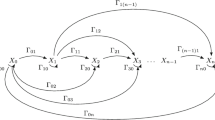Summary
The problem of two bodies with a central-force potential is treated by means of a relativistic Hamiltonian multi-time formalism. It is shown that only a Newtonian potential is compatible within this formalism, thus stating an exception of the so-called no-interaction theorems. The relativistic meaning of the Runge-Lenz vector of the classical Kepler problem is revealed.
Similar content being viewed by others
References
Sommerfeld, A.: Atombau und Spektrallinien. Braunschweig: Vieweg 1919.
Dirac, P. A. M., Fock, V. A., Podolsky, B. On quantum electrodynamics. Phys. Zeitschr. d. Sowjetunion.2, 468–479 (1932). [Reprinted in:Schwinger, J. ed.: Selected papers on quantum electrodynamics. New York: Dover Publications 1958]
Stickforth, J.: Unique distinction of the Lorentz and the anti-de Sitter group in the classical Kepler problem. Int. J. Theor. Phys.16, 409–417 (1977).
Kerner, E. H., ed.: The theory of action-at-a-distance in relativistic particle dynamics. A reprint collection. New York London Paris: Gordon and Breach 1972.
Author information
Authors and Affiliations
Rights and permissions
About this article
Cite this article
Stickforth, J. The Kepler problem in relativistic multi-time formalism. Part I. Acta Mechanica 123, 187–193 (1997). https://doi.org/10.1007/BF01178409
Received:
Revised:
Issue Date:
DOI: https://doi.org/10.1007/BF01178409




